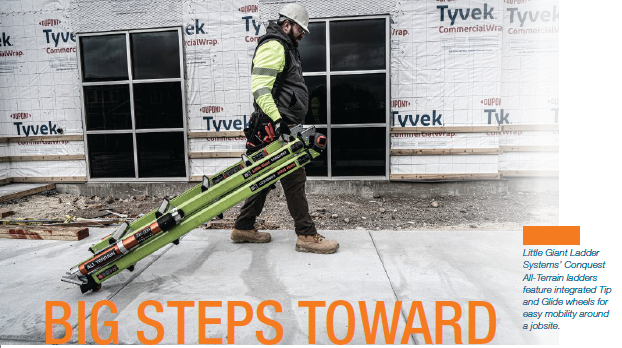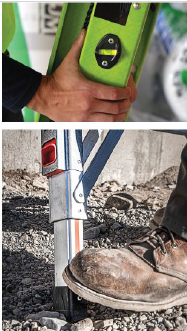 |
A SAFER FUTURE
THE ONGOING EVOLUTION OF LADDER SAFETY
By David Francis, Little Giant Ladder Systems
Since the dawn of time, humans have found ways to elevate themselves to reach greater heights – whether for survival, work or play. Ladders have been integral to human history, with even 10,000-year-old Spanish cave paintings depicting people using ladders to gather honey. While the concept of the ladder has evolved significantly since then, from ancient wooden and rope ladders to the modern, highly engineered designs we rely on today, its purpose has remained the same. At Little Giant, we believe that a ladder’s purpose should not only be to help its user work at height, but also to ensure the user reaches the ground safely.
CHALLENGES
Although ladders have evolved over the last 10,000 years, ladder-related accidents remain a serious concern within workplaces.
The Centers for Disease Control and Prevention (CDC) has reported that more than half a million people are treated for ladder-related injuries each year in the United States alone; nearly 300 people succumb to their injuries. A simple misstep can lead to permanent life-altering or life-ending consequences.
For professionals using ladders daily, it is critical to prioritize education, training, and the proper use of equipment. The good news is that industry-wide efforts to improve ladder safety are starting to yield measurable results.
According to the 2024 Ladder Safety Training and Citations Survey conducted by the American Ladder Institute (ALI), there has been a 21% decrease in ladder-related accidents resulting in severe injury or loss of life between 2020 and 2024. This decline in ladder-related accidents reflects the collective commitment of industry leaders, organizations, professionals, and individuals alike, striving to implement the best and safest practices in ladder use.
The data shows that the most frequently reported ladder-related accidents stem from improper setup or use of the wrong ladder for a specific application. These preventable mistakes highlight the importance of adhering to manufacturer guidelines and proper ladder selection. It is important to celebrate the progress that has been made, but there is still work to do.
RAISING AWARENESS
To emphasize the importance of ladder safety across industries, the inaugural National Ladder Safety Month launched in 2017, spearheaded by Ryan Moss, CEO of Little Giant Ladder Systems, during his tenure as president of the American Ladder Institute.
National Ladder Safety Month is designed to help reduce the number of ladder-related injuries and fatalities, lower the number of ladder-related safety citations from the Occupational Safety and Health Administration (OSHA) and increase the number of ladder safety training certifications. The objectives align with the industry’s broader efforts to foster a culture of safety and promote ongoing education to prevent ladder-related accidents.
CULTURE OF SAFETY
Regulatory compliance is a major driver of workplace safety improvements. OSHA establishes guidelines for proper ladder use and conducts inspections to identify violations and issue citations for non-compliance.
While meeting OSHA standards is a mandated component of workplace safety, organizations that go beyond compliance are the ones making the greatest strides.
Implementing clear guidelines for ladder selection, emphasizing proper setup techniques and conducting regular safety audits can reinforce best practices and reduce the likelihood of accidents.
Companies that prioritize open discussions about safety concerns and encourage employees to report hazards can further strengthen their safety programs.
Ladder safety training has been a significant tool for reducing workplace accidents. Nearly all organizations (98%) now utilize some form of ladder safety training, and the percentage of companies paying for these programs has grown by 7% over the past four years. In addition to initial ladder safety training, a recent survey showed that 64% of organizations require annual safety training refresher courses. An investment in education is an indication that businesses recognize the value of proactive safety measures.
 |
| New ladder designs may incorporate stability enhancements, fall prevention features and built-in safety mechanisms that help reduce potential for human error. |
A SAFER CLIMB
While ladder safety training and awareness are critical, we believe manufacturers have a responsibility to design equipment that is safer for the user. New ladder designs may incorporate stability enhancements, fall prevention features and built-in safety mechanisms that help reduce potential for human error.
Examples of safety innovations include Little Giant’s GroundCue, which provides an audible and tactile signal that a user has reached the bottom step. The reason for the development came from early step-offs being one of the most common causes of ladder-related falls. Similarly, Little Giant’s Hi-Viz Green fiberglass was designed to make the ladders easier to spot, improving overall awareness on a jobsite.
Looking ahead, industry leaders must continue to advocate for improved training, enhanced equipment, and a proactive approach to safety. By leveraging emerging technologies, we can further reduce ladder-related accidents and create safer job sites for all.
The data tells a compelling story, progress is possible when safety is a priority. At Little Giant, we are proud to play a role in shaping this safer future, because every worker deserves to go home safely at the end of the day. We encourage all organizations to take an active stance in ladder safety, not just for compliance, but for the well-being of every worker who steps onto a ladder.
Dave Francis, is the national safety director for Little Giant Ladder Systems and leads its free safety training program.
This article originally appeared in the April/May 2025 issue of Contractor Supply magazine. Copyright, 2025 Direct Business Media.
















